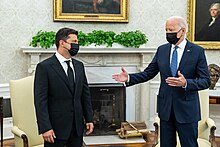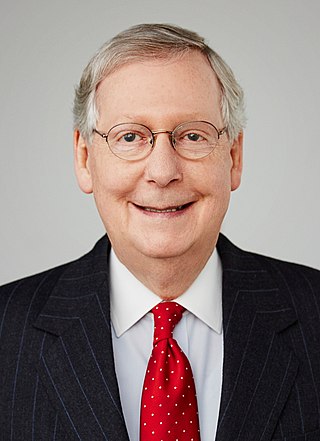
Addison Mitchell McConnell III is an American politician and retired attorney who has served as Senate Minority Leader since 2021 and the senior United States senator from Kentucky since 1985, the longest serving senator in his state's history. He previously served as minority leader from 2007 to 2015, majority leader from 2015 to 2021 and was majority whip from 2003 to 2007. McConnell has been the leader of the Senate Republican Conference since 2007, making him the longest serving Senate party leader in U.S. history.

Michael Richard Pence is an American politician who served as the 48th vice president of the United States from 2017 to 2021 under President Donald Trump. A member of the Republican Party, he previously served as the 50th governor of Indiana from 2013 to 2017, and a member of the U.S. House of Representatives from 2001 to 2013.
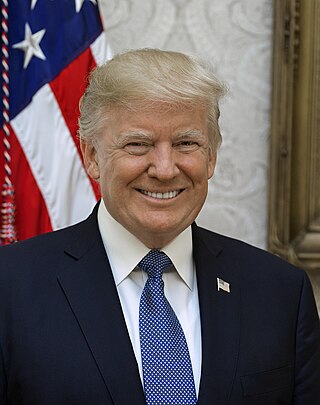
Donald John Trump is an American politician, media personality, and businessman who served as the 45th president of the United States from 2017 to 2021.

Ronald Harold Johnson is an American politician serving as the senior United States senator from Wisconsin, a seat he has held since 2011. A Republican, Johnson was first elected to the U.S. Senate in 2010, defeating Democratic incumbent Russ Feingold. He was reelected in 2016, defeating Feingold in a rematch, and in 2022, narrowly defeating Lieutenant Governor Mandela Barnes.
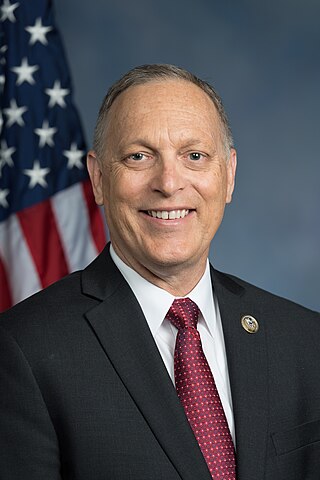
Andrew Steven Biggs is an American attorney and politician who represents Arizona's 5th congressional district in the United States House of Representatives. The district, which was once represented by U.S. Senators John McCain and Jeff Flake, is in the heart of the East Valley and includes most of Mesa and Chandler and all of Queen Creek and Biggs's hometown of Gilbert.
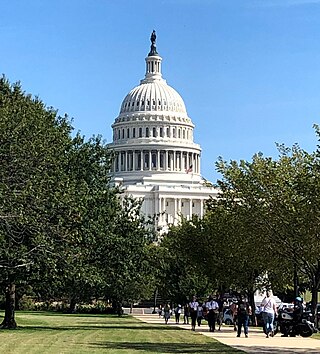
The 117th United States Congress was a meeting of the legislative branch of the United States federal government, composed of the United States Senate and the United States House of Representatives. It convened in Washington, D.C., on January 3, 2021, during the final weeks of Donald Trump's presidency and the first two years of Joe Biden's presidency and ended on January 3, 2023.

The 2020 United States presidential election was the 59th quadrennial presidential election, held on Tuesday, November 3, 2020. The Democratic ticket of former vice president Joe Biden and the junior U.S. senator from California Kamala Harris defeated the incumbent Republican president, Donald Trump, and vice president, Mike Pence. The election took place against the backdrop of the global COVID-19 pandemic and related recession. The election saw the highest voter turnout by percentage since 1900, with each of the two main tickets receiving more than 74 million votes, surpassing Barack Obama's record of 69.5 million votes from 2008. Biden received more than 81 million votes, the most votes ever cast for a candidate in a U.S. presidential election.
This section of the timeline of United States history includes major events from 2010 to the present.
The following is a list of notable events, births and deaths from 2020 in the United States.
Events in 2020 pertaining to politics and government in the United States.
Events in 2021 pertaining to politics and government in the United States.
This article outlines United States-related events which occurred in the year 2021.

The federal government of the United States initially responded to the COVID-19 pandemic in the country with various declarations of emergency, some of which led to travel and entry restrictions and the formation of the White House Coronavirus Task Force. As the pandemic progressed in the U.S. and globally, the U.S. government began issuing recommendations regarding the response by state and local governments, as well as social distancing measures and workplace hazard controls. State governments played a primary role in adopting policies to address the pandemic. Following the closure of most businesses throughout a number of U.S. states, President Donald Trump announced the mobilization of the National Guard in the most affected areas.

The following is a timeline of the presidency of Donald Trump during the fourth and last quarter of 2020, from October 1 to December 31, 2020. This is also during the final month of his presidency from January 1 to 20, 2021, when Trump left office. To navigate quarters, see timeline of the Donald Trump presidency.

Joe Biden's tenure as the 46th president of the United States began with his inauguration on January 20, 2021. Biden, a Democrat from Delaware who previously served as vice president for two terms under President Barack Obama, took office following his victory in the 2020 presidential election over Republican incumbent president Donald Trump. Upon his inauguration, he became the oldest president in American history, breaking the record set by his predecessor Trump. Biden entered office amid the COVID-19 pandemic, an economic crisis, and increased political polarization.
The following is a timeline of major events leading up and during the 2020 United States presidential election, the 59th quadrennial United States presidential election, from January to October 2020. For previous events, see Timeline of the 2020 United States presidential election (2017–2019). For subsequent events, see Timeline of the 2020 United States presidential election

The following is a timeline of the presidency of Joe Biden during the first quarter of 2021, beginning from his inauguration as the 46th president of the United States on January 20, 2021, to March 31, 2021. To navigate between quarters, see timeline of the Joe Biden presidency. For the Q2 timeline see timeline of the Joe Biden presidency.

In the aftermath of the January 6 United States Capitol attack, after drawing widespread condemnation from the U.S. Congress, members of his administration, and the media, 45th U.S. President Donald Trump released a video-taped statement on January 7 to stop the resignations of his staff and the threats of impeachment or removal from office. In the statement, he condemned the violence at the U.S. Capitol, saying that "a new administration will be inaugurated", which was widely seen as a concession, and his "focus now turns to ensuring a smooth, orderly, and seamless transition of power" to the Joe Biden administration. Vanity Fair reported that Trump was at least partially convinced to make the statement by U.S. Senator Lindsey Graham (R-SC), who told Trump a sufficient number of Senate Republicans would support removing him from office unless he conceded. Kayleigh McEnany, the White House Press Secretary, had attempted to distance the administration from the rioters' behavior in a televised statement earlier in the day. On January 9, The New York Times reported that Trump had told White House aides he regretted committing to an orderly transition of power and would never resign from office. In a March 25 interview on Fox News, Trump defended the Capitol attackers, saying they were patriots who posed "zero threat", and he criticized law enforcement for "persecuting" the rioters.

Donald Trump's farewell address was the final official speech of Donald Trump as the 45th President of the United States, delivered as a recorded, online video message on January 19, 2021. The farewell address was delivered the day before Joe Biden, who defeated him in the 2020 United States presidential election, was sworn in as his successor. Trump was the first president to not attend his successor's inauguration since Andrew Johnson in 1869.

The first 100 days of Joe Biden's presidency began on January 20, 2021, the day Joe Biden was inaugurated as the 46th president of the United States. The first 100 days of a presidential term took on symbolic significance during Franklin D. Roosevelt's first term in office, and the period is considered a benchmark to measure the early success of a president. The 100th day of his presidency ended at noon on April 30, 2021.



